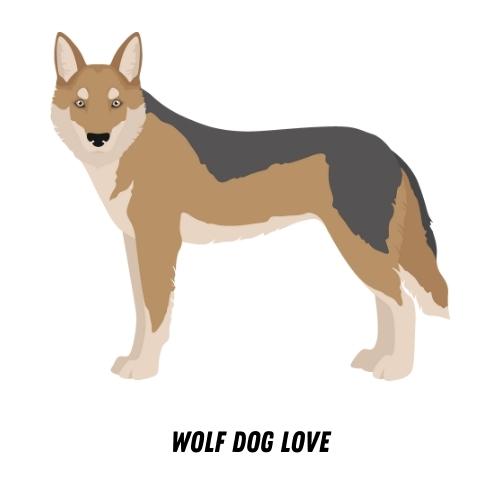Introduction to Wolf Dog Training Techniques
Wolf dogs are unique creatures, possessing the wild instincts of a wolf and the domestic traits of a dog. Training them requires a special approach, understanding their unique challenges and harnessing their canine instincts. In this post, we will explore these aspects in detail.
- Understanding the Unique Challenges of Wolf Dog Training
- Importance of Harnessing Canine Instincts in Training
Training a wolf dog is not like training a regular dog. These animals have a strong instinctual drive, which can make them more challenging to train. They are intelligent, independent, and can be stubborn. They also have a high prey drive and can be territorial. Understanding these challenges is the first step to successful wolf dog training.
Wolf dogs are not just dogs, they are part wolf. This means they have instincts that are different from domestic dogs. Harnessing these instincts in training is crucial. For instance, wolf dogs have a strong pack mentality. Using this instinct, you can establish yourself as the pack leader and guide their behavior. Similarly, their high prey drive can be channeled into tasks and games that satisfy this instinct.
Training a wolf dog is not an easy task, but with patience, understanding, and the right techniques, it can be a rewarding experience. In the following sections, we will delve deeper into understanding wolf dog instincts and how to harness them for successful training.
Understanding Wolf Dog Instincts
Wolf dogs, as their name suggests, are a unique blend of wolf and dog. This makes them a fascinating, yet challenging, pet to understand and train. To effectively train a wolf dog, it’s crucial to understand their instincts and how they differ from those of typical dogs.
- Key differences between wolf and dog instincts
While dogs have been domesticated for thousands of years, wolves are wild animals. This fundamental difference results in distinct instincts.
Dogs, for instance, are naturally social animals that thrive in a pack environment. They are bred to work alongside humans, which makes them more likely to follow commands and seek approval. Wolves, on the other hand, are more independent and self-reliant. They are natural hunters and are driven by survival instincts.
Wolf dogs, being a mix of the two, can exhibit a range of behaviors. Some may lean more towards their wolf instincts, while others may behave more like dogs. It’s important to note that no two wolf dogs are the same, and their instincts can vary greatly.
- How understanding these instincts can aid in training
Understanding the instincts of your wolf dog is the first step towards effective training. Recognizing their unique blend of wolf and dog instincts can help you tailor your training approach to suit their needs.
For instance, if your wolf dog exhibits more dog-like behavior, traditional dog training methods may work well. However, if they show more wolf-like instincts, you might need to adapt your approach, focusing more on building trust and establishing yourself as a leader of the pack.
Remember, patience and consistency are key when training a wolf dog. It may take time, but understanding their instincts and adapting your training methods accordingly can lead to a rewarding and enriching experience for both you and your wolf dog.
In the next section, we will delve deeper into specific training techniques that harness these canine instincts.
Training Wolf Dogs: Harnessing Canine Instincts
Training a wolf dog requires a deep understanding of their natural instincts and behaviors. This section will provide you with essential strategies for managing your wolf dog’s behavior effectively.
Wolf Dog Behavior Management
Managing a wolf dog’s behavior involves three key steps: establishing dominance and respect, creating a structured environment, and consistently reinforcing rules and boundaries. Let’s delve into each of these steps in detail.
- Establishing Dominance and Respect
- Creating a Structured Environment
- Consistent Reinforcement of Rules and Boundaries
Wolf dogs are pack animals, and they naturally look for a leader. As an owner, you need to establish yourself as the pack leader. This doesn’t mean being harsh or aggressive. Instead, it’s about showing confidence, setting rules, and maintaining consistency. When your wolf dog sees you as a leader, they will respect you and follow your commands.
Wolf dogs thrive in a structured environment. This means having set times for meals, walks, and play. A routine gives your wolf dog a sense of security and helps them understand what is expected of them. It’s also important to provide them with plenty of physical and mental stimulation to prevent boredom and destructive behavior.
Consistency is key when training a wolf dog. Once you’ve set rules and boundaries, you need to reinforce them consistently. This means rewarding good behavior and correcting bad behavior every time. Remember, inconsistency can confuse your wolf dog and make training more difficult.
In conclusion, managing a wolf dog’s behavior is not about controlling them, but about understanding their instincts and working with them. With patience, consistency, and respect, you can harness your wolf dog’s instincts and create a strong, positive bond with them.
Wolf Dog Training Approaches
Training a wolf dog requires a unique approach. Here are three effective methods that can help you train your wolf dog successfully:
- Positive Reinforcement Techniques
- Clicker Training
- Behavioral Shaping
Positive reinforcement is a powerful tool in wolf dog training. This approach involves rewarding your wolf dog for good behavior, which encourages them to repeat it. Rewards can be anything your wolf dog loves, such as treats, praise, or playtime. For example, if your wolf dog sits when you command, give them a treat or a pat on the head. This shows them that sitting on command leads to good things, making them more likely to do it again in the future.
Clicker training is another effective method for wolf dogs. This technique uses a small device that makes a distinct ‘click’ sound. The clicker is used to mark the exact moment your wolf dog performs the desired behavior. After the click, you immediately reward your wolf dog. Over time, they learn to associate the ‘click’ with doing something right, and they’ll strive to hear that sound. Remember, timing is crucial in clicker training. The click must occur at the exact moment your wolf dog does what you want.
Behavioral shaping involves gradually teaching your wolf dog a new behavior by rewarding them for small steps towards the desired action. For instance, if you want your wolf dog to lie down on command, you might start by rewarding them for simply bending their legs. Over time, you reward them for getting closer and closer to the full ‘down’ position. This method requires patience, but it can be highly effective in teaching complex behaviors.
Remember, every wolf dog is unique, and what works for one might not work for another. It’s important to be patient, consistent, and positive in your training approach. With time and effort, your wolf dog can learn to follow commands and exhibit good behavior.
Taming Wolf Dog Instincts: Training Methods for Wolf Dogs
Wolf dogs are unique creatures that combine the instincts of a wild wolf and the domesticity of a dog. One of the most significant challenges in training wolf dogs is managing their strong prey drive. But with the right understanding and techniques, it’s possible to tame these instincts and have a well-behaved wolf dog.
Understanding and Controlling Prey Drive
Prey drive is a natural instinct in many animals, including wolf dogs. It’s the urge to chase, catch, and sometimes kill smaller creatures. This instinct is particularly strong in wolf dogs due to their wolf heritage.
- What is prey drive and why is it strong in wolf dogs?
- Techniques for controlling and redirecting prey drive
Prey drive is an instinctual behavior that is triggered by the sight, sound, or smell of potential prey. In wolf dogs, this instinct is especially strong because of their wolf ancestry. Wolves are natural hunters, and this trait is often passed down to their hybrid offspring. Understanding this is the first step towards controlling and redirecting this instinct in a positive way.
Controlling and redirecting a wolf dog’s prey drive requires patience, consistency, and the right techniques. One effective method is to use toys or games that mimic hunting behaviors, such as fetch or tug-of-war. This provides a safe and controlled outlet for their prey drive. Training commands like ‘leave it’ or ‘drop it’ can also be useful in managing this instinct. Remember, it’s not about suppressing their natural instincts, but rather redirecting them in a positive and controlled manner.
Training a wolf dog is not an easy task, but with understanding, patience, and the right techniques, it’s possible to tame their wild instincts and have a well-behaved and happy pet.
Harnessing Animal Instincts for Training
Training a wolf dog can be a challenging task. However, by understanding and harnessing their natural instincts, we can make the process much easier and more effective. Let’s explore how we can use these instincts as a training tool and look at some examples of instinct-based training methods.
- Using Natural Instincts as a Training Tool
Wolf dogs, like their wild counterparts, have strong instincts. These instincts, such as prey drive, pack mentality, and territorial behavior, can be harnessed to aid in training. For example, using their pack mentality, we can establish ourselves as the ‘pack leader’ and guide their behavior accordingly. Similarly, their territorial instinct can be used to teach them boundaries within the home.
It’s important to remember that these instincts are not ‘bad’. They are a part of the wolf dog’s nature. Our goal is not to suppress these instincts, but to guide them in a way that is beneficial for both the wolf dog and its human family.
- Examples of Instinct-Based Training Methods
Here are a few examples of how we can use a wolf dog’s natural instincts in training:
| Instinct | Training Method |
|---|---|
| Prey Drive | Use toys that stimulate their prey drive, such as squeaky toys or toys that move. This can be used to teach commands like ‘fetch’ or ‘drop it’. |
| Pack Mentality | Establish yourself as the ‘pack leader’ by setting rules and boundaries. This can help in teaching commands like ‘sit’, ‘stay’, or ‘come’. |
| Territorial Behavior | Use their territorial instinct to teach them boundaries within the home. This can be done by designating certain areas as ‘their space’ and others as ‘off-limits’. |
Remember, every wolf dog is unique and what works for one might not work for another. It’s important to be patient and consistent in your training methods. With time and effort, you can harness their natural instincts to create a strong bond and a well-behaved companion.
Case Studies: Successful Wolf Dog Training Techniques
Let’s take a look at some real-life examples of successful wolf dog training techniques. These case studies highlight the effectiveness of various methods and provide practical insights for wolf dog owners.
-
Case study 1: Using positive reinforcement to manage behavior
In this case, a wolf dog named Max was trained using positive reinforcement. The trainer rewarded Max with treats and praise whenever he followed a command correctly. Over time, Max began to associate good behavior with rewards, leading to a significant improvement in his overall behavior.
Training Technique Results Positive Reinforcement Improved Behavior -
Case study 2: Controlling prey drive in a wolf dog
A wolf dog named Luna had a strong prey drive, which made her difficult to manage. Her trainer used a technique called “impulse control training” to help Luna control her instincts. This involved teaching Luna to resist her natural impulses and wait for her owner’s command before acting. After several weeks of training, Luna’s prey drive was significantly reduced.
Training Technique Results Impulse Control Training Reduced Prey Drive -
Case study 3: Successful integration of a wolf dog into a family environment
In this case, a wolf dog named Rocky was successfully integrated into a family with two young children. The family used a combination of obedience training and socialization techniques to help Rocky adjust to his new environment. Rocky quickly became a beloved member of the family, demonstrating the effectiveness of these training techniques.
Training Techniques Results Obedience Training and Socialization Successful Family Integration
These case studies demonstrate that with the right training techniques, wolf dogs can be successfully managed and integrated into various environments. Remember, every wolf dog is unique and may respond differently to different training techniques. It’s important to be patient and consistent in your training efforts.
Conclusion: Unleashing the Potential of Your Wolf Dog
As we conclude this comprehensive guide on wolf dog training, let’s take a moment to revisit the key takeaways and understand the importance of patience and consistency in training your wolf dog.
- Recap of key takeaways:
- The importance of patience and consistency in training:
Wolf dogs are unique creatures that require a special approach to training. Understanding their instincts is crucial for effective training. We’ve learned that harnessing these instincts, rather than trying to suppress them, can lead to successful outcomes. We’ve also explored various training methods and heard from successful case studies. Remember, every wolf dog is different, and what works for one might not work for another.
Training a wolf dog is not a task that can be completed overnight. It requires a great deal of patience and consistency. Consistent training helps your wolf dog understand what is expected of them, and patience allows you to remain calm and composed, even when progress seems slow. Remember, the journey of training your wolf dog is just as important as the destination.
With the right approach, understanding, and commitment, you can unleash the true potential of your wolf dog. Remember, the bond you form with your wolf dog during this process is invaluable and will serve as the foundation of your lifelong relationship. Happy training!








